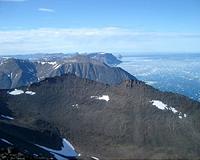| . |  |
. |
Paris, France (SPX) Sep 21, 2010 The Earth's mantle and its core mix at a distance of 2900 km under our feet in a mysterious zone. A team of geophysicists has just verified that the partial fusion of the mantle is possible in this area when the temperature reaches 4200 Kelvin. This reinforces the hypothesis of the presence of a deep magma ocean. The originality of this work, carried out by the scientists of the Institut de mineralogie et de physique des milieux condenses (UPMC/ Universite Paris Diderot/ Institut de Physique du Globe/CNRS/IRD), lies in the use of X-ray diffraction at the European Synchrotron Radiation Facility in Grenoble (France). The results will have an effect in the understanding of the dynamics, composition and the formation of the depths of our planet. On top of the core of the Earth, constituted of liquid iron, lies the solid mantle, which is made up essentially of magnesium oxides, iron and silicon. The border between the core and the mantle, located at 2900 km under our feet, is highly intriguing to geophysicists. With a pressure of around 1.4 million times the atmospheric pressure and a temperature of more than 4000 Kelvin, this zone is the home to chemical reactions and changes in states of matter still unknown. The seismologists who have studied this subject have acknowledged an abrupt reduction of the speed of the seismic waves, which sometimes reach 30% when getting close to this border. This fact has led scientists to formulate the hypothesis, for the last 15 years, of the partial melting of the Earth mantle at the level of this mantle-core border. Now it has been confirmed. In order to access the depths of the Earth, scientists have not only seismological images but also a precious experimental technique: diamond anvil cells, coupled with a heating layer. This instrument allows to re-create the same pressure and temperature condition than those in the interior of the Earth, on samples of a few microns. This is the technique used by the researchers of the Institut de mineralogie et de physique des milieux condenses on natural samples that are representatives of the Earth mantle and that have been put under pressures of more than 140 gigapascals (or 1.4 million times the atmospheric pressure), and temperatures of more than 5000 Kelvin. A new approach to this study has been the use of the X-ray diffraction technique at the European synchrotron ESRF. This has allowed the scientists to determine what mineral phases melt first, and they have also established, without extrapolation, fusion curves of the deep Earth mantle, i.e. the characterization of the passage from a solid state to a partially liquid state. Their observations show that the partial fusion of the mantle is possible when the temperature approaches 4200 Kelvin. These experiments also prove that the liquid produced during this partial fusion is dense and that it can hold multiple chemical elements, among which are important markers of the dynamics of the Earth mantle. These studies will allow geophysicists and geochemists to achieve a deeper knowledge of the mechanisms of differentiation of the Earth and the history of its formation, which started around 4.5 billion years ago.
Share This Article With Planet Earth
Related Links European Synchrotron Radiation Facility Dirt, rocks and all the stuff we stand on firmly
 Oldest Earth Mantle Reservoir Discovered
Oldest Earth Mantle Reservoir DiscoveredArlington VA (SPX) Aug 13, 2010 Researchers have found a primitive Earth mantle reservoir on Baffin Island in the Canadian Arctic. Geologist Matthew Jackson and his colleagues from a multi-institution collaboration report the finding--the first discovery of what may be a primitive Earth mantle--this week in the journal Nature. The Earth's mantle is a rocky, solid shell that is between the Earth's crust and the outer core ... read more |
|
| The content herein, unless otherwise known to be public domain, are Copyright 1995-2010 - SpaceDaily. AFP and UPI Wire Stories are copyright Agence France-Presse and United Press International. ESA Portal Reports are copyright European Space Agency. All NASA sourced material is public domain. Additional copyrights may apply in whole or part to other bona fide parties. Advertising does not imply endorsement,agreement or approval of any opinions, statements or information provided by SpaceDaily on any Web page published or hosted by SpaceDaily. Privacy Statement |